Thinking of starting a drop shipping business? Or starting your own OEM products and selling it as a side hustle?
Unless you are selling B2B, chances are you’ll need a website presence so people can find you easily. In this article we’ll go through how you can easily kickstart your own SEO campaign in Singapore from scratch and get leads through search engines. Let’s get started!
1. Competitive Research
Before you start investing ad dollars or time into writing your first blog for SEO, finding gout what your closest competitors or the best-performing ones are doing can save you a lot of time and resources.
For the best results, simply look for competitors whose primary strategy is to gain leads via Google ads or SEO. You can easily find out who these competitors are by looking for the top players who have competing keywords similar to yours.
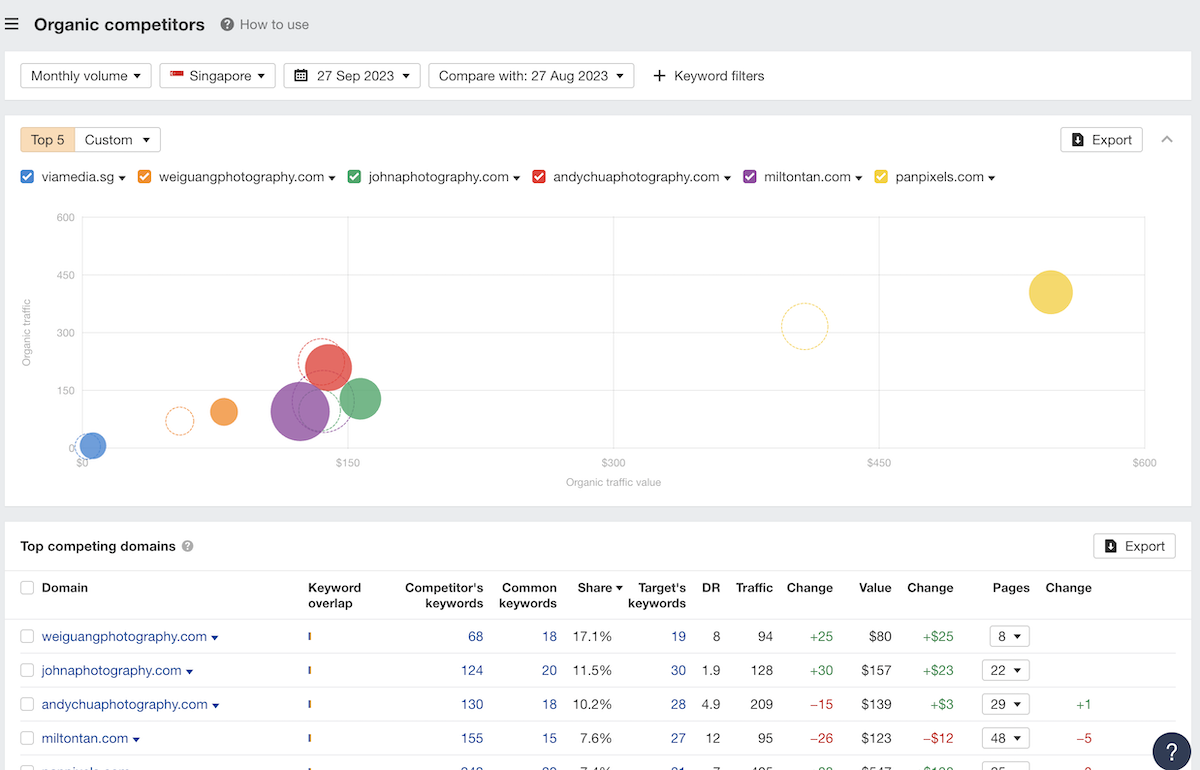
Knowing this is crucial as you can easily see which of these competitors are investing heavily in organic search, a.k.a. SEO.
Another method will be to look for competitors using Google search engine itself. Simply type in the words you feel are important for customers to find you, can check the top competitors’ site traffic. You can also easily find this information in Ahrefs keyword research.
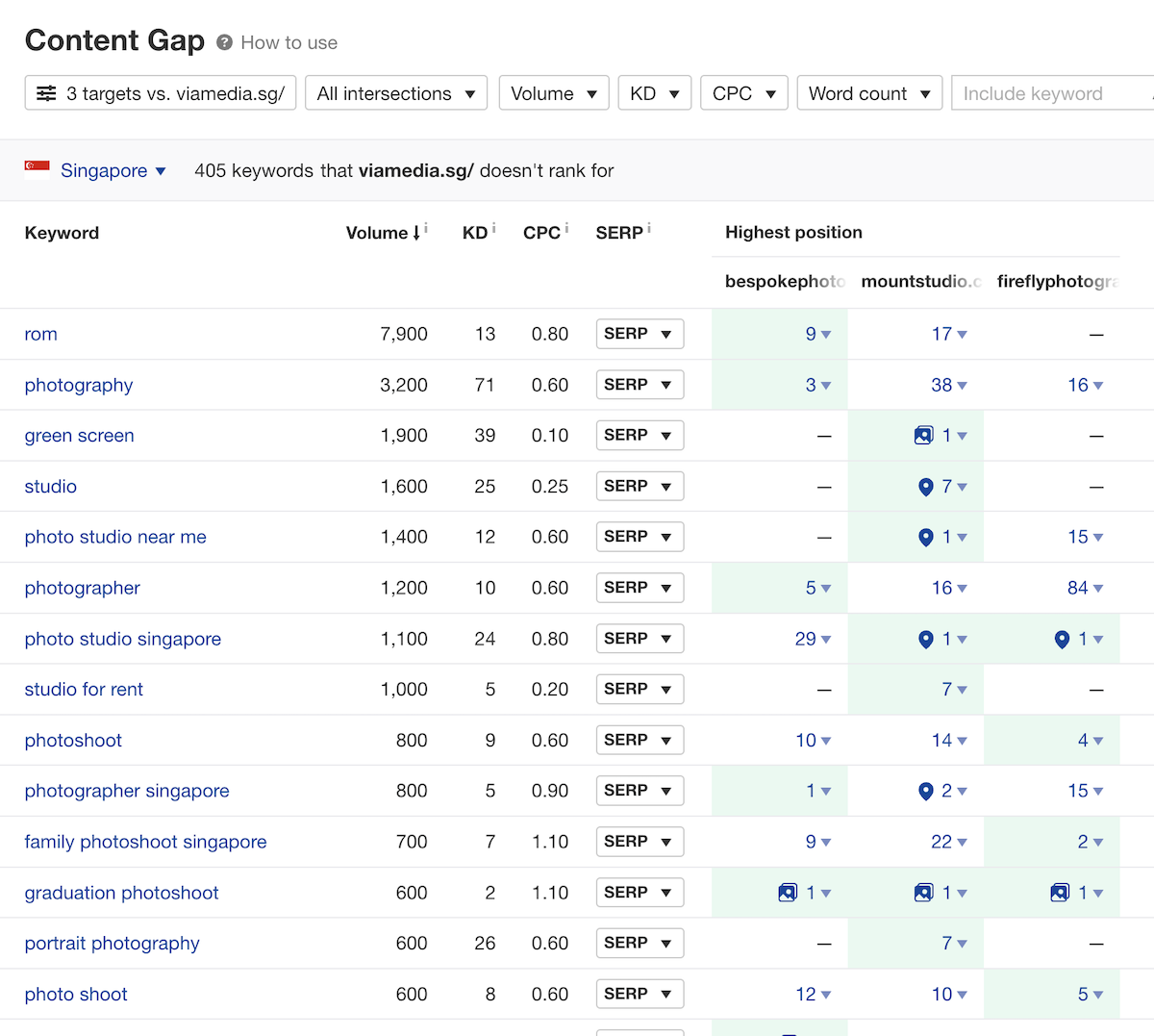
If you’d like to read more, here’s an in-depth guide on competitor analysis.
2. Keyword Research
Knowing the right keywords to target is half the battle won. This alone can often save you hours of research and effort on targeting the wrong keywords.
So how do you know what keywords to target? The first step is to find out who are the top competitors in your industry relying on SEO for their marketing. For that, you can refer to the competitor analysis step above.
Say you are a local florist in Singapore, and currently sells a wide variety of flowers. You can easily find more keywords to target by looking for the strongest competitors in your industry, and find out what are their strongest pages (in terms of SEO).

From these pages, you can then find out the keywords these pages are ranking for, and then target them. For SEO competitive analysis, you first look at their top-performing pages.
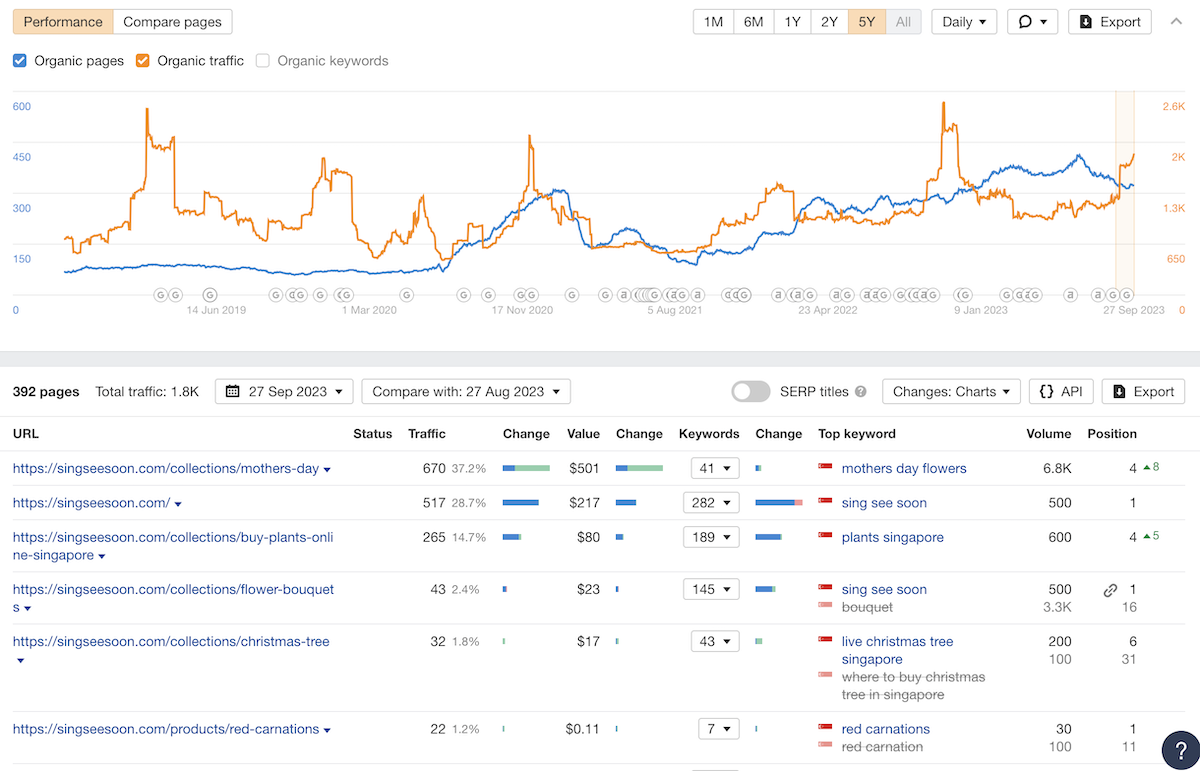
Say you are targeting some specific terms like “roses” or “babybreaths”. Now with this expanded range of keywords, you can find more keywords, such as “flower delivery”, “flower bouquet” and “flower stands” to target.
If you’d like to read more in-depth on SEO keyword research in Singapore, read this article.
3. Technical SEO
Readability of page by bots
Through our past experience with dozens of clients, some sites can have the best UIUX for users – quick loading speed, beautifully designed graphics, SEO optimised content. However, if they are readable by Google bots, they are effectively useless at ranking.
These sites never see more than a handful of traffic and may even not be crawled by search engine spiders. This is where sites such as https://prerender.io/ come in handy, where they serve cached pages to search engine crawlers so that its Javascript can be read properly.
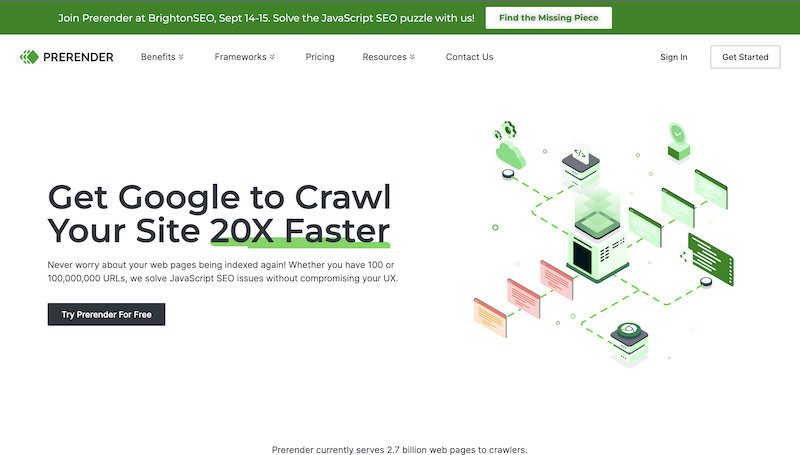
Once your website can be read by Google, it will be much easier to rank for the wanted keywords.
Robots.txt
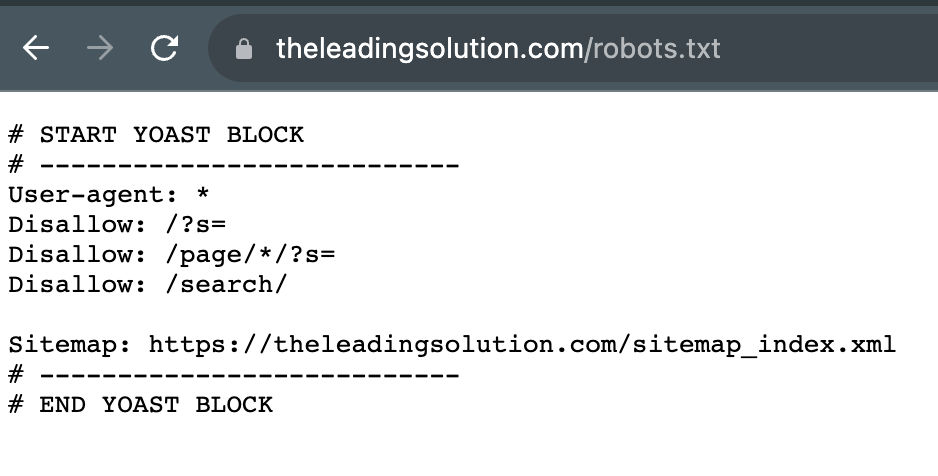
Having a robots.txt file is crucial as it tells Google which of your pages should be crawled.
If you are running a portal with a member login feature, for example, you may want Google to skip crawling these pages.
Without this directive, Google will continue crawling and indexing these inner pages, which could include members’ bio and sensitive personal information such as their home address (depends on your portal and configuration, but you get the idea).
Imagine having this sensitive information on Google. While legal repercussions may be a bit extreme, these inner pages usually lack quality and are irrelevant to ranking.
Take a look at Moz, which has increased their traffic by simply no-indexing their user profiles. You can also do so by preventing Google bots from crawling them.
4. On-Page SEO
No matter how advanced search engines become, at their core, they are just crawlers with an algorithm to calculate the score of a page.
Though it is perfectly to think that these crawlers, or “spiders” are smart enough to understand a page, be it photos or videos, or that it matches the search intent of users, our research shows that having an optimised on-page SEO still does wonders.
The first step, of course, is to make sure the bots understand your page well. This is why we feel technical SEO is more important than on-page SEO. However, having a readable page but one that has thin or filler content is also detrimental to your website.
Meta titles, meta-descriptions
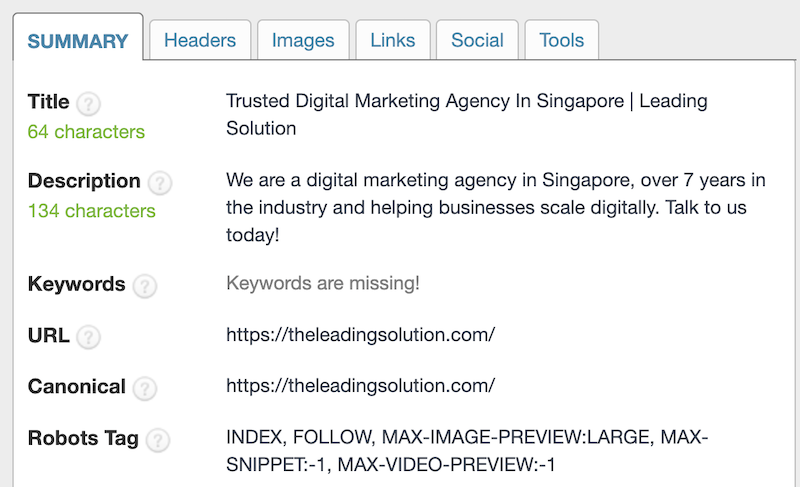
Meta-titles and descriptions are the next most important thing in line to tell Google what the page is about. While your content can tell them what the page is about, having an optimised meta-title helps your Google user understand better what your page is about from search engines.
Imagine the page being a business – without a google salesman (aka meta titles and meta description in this case), potential buyers will not even step foot on your business (aka website in this case).
Having attractive or eye-capturing meta-information helps too. Having a high click-through-rate (CTR) generally helps a website’s performance as they are deemed “relevant” to the users searches.
However, generally beware of using malicious or ill-intent meta titles and descriptions, as a high bounce rate can be detrimental to your site, on top of the fact search engines probably know the mismatch of meta information and page content, signalling manipulation intent to them and force them to rate your content as “lower-quality”.
Sometimes, Google may not take your desired meta titles and descriptions too. Note this is nothing to be alarmed about, as their algorithm may choose their own words or pick out part of your page as a better option than what you have input.
(show example)
Despite this, it is generally helpful to have an optimised meta title and description, to give the right signal to Google and improve overall SEO score.
On-page content creation
If you are churning blogs or content for the sake of increasing keywords and thinking it will ultimately benefit SEO, stop doing it.
In our experience, there are many clients that have done so and have yet to achieve mediocre results.
Firstly, thin or filler content will not benefit your site. Think about it – if you were Google, would you rank a site with a hundred low-quality, 100-500 worded blogs with no aim and planning, or would you rank a site with maybe 10-20 pieces of content, but are well-researched, extremely informative for users?
The answer is obvious. This is why we often do constant content audits for our clients, advising them to either merge, delete or improve their content.
This is where a content marketing or content creation agency can come in handy.
How do we know if the content is “good quality” according to Google?
Our technical team will run frequent updates on how frequently Google crawl your pages, and it gives a good idea of the health and importance of the page to Google.
(Insert screenshot)
In general, the better ranked or higher-quality your pages are to Google, the more they will crawl these websites or pages.
If you are looking to read more in-depth, check out this guide about how to do on-page SEO.
Alt text
A good way to do quick optimisation on-page is to fill in alternate texts with optimised keywords.
A good practice is to add in variations of the keywords you want to rank for while describing the picture.
Spamming keywords in alt texts is a thing of the past – overdoing this step may cause penalisation, so don’t overdo this step.
4. Off-Page SEO
Out of so many domains, and subdomains out there, have you ever thought about how search engines rank these websites? What makes a page or domain better than the other? Or rather, is there a difference between a page and a domain?
A short answer is, in order to rank well, you typically need to be good in either 1 – page or domain (of course, being good in both will be the best-case scenario). So, how do search engines rank these pages or domains, and how can I get a sense of a website’s “quality score”?
Domain Rating (DR) / Domain Authority (DA)
This is one of the metrics frequently used by SEOs to determine the “authority” of a website at the domain level.
Frequently called Domain Rating (by Ahrefs) or Domain Authority (by Moz), these numbers tell you, in general, how many different domains link to your domain, and the score is calculated linearly.
(Insert ahrefs screenshots)
Note – even extremely spammy domains can get a high DR/DA score, as long as the total sum of all DR/DAs linking to the site is substantial enough.
Unique Rating (UR)/Page Authority (PA)/ Google Page Rank (PR)
This is another metric often used by SEOs to see if a page can rank.
This happens when you Google something and an unknown site ranks high in searches. This can happen when a lot of relevant, high-quality links link to a page (different from domain), and that page ranks highly for that term. It can be a brand-new site, and if that particular page has a lot of links to it, it can rank highly too.
(Insert screenshot)
So, is Domain Rating (DR) or Unique (UR) better?
If you are looking to read more in-depth, check out this guide about how to do off-page SEO.
Backlinks
Out of all on-page, and off-page practices, perhaps the most important one is link-building. Have you ever seen a page with seemingly little content, yet it’s ranking highly? It is usually the links at play.
While many agencies may say backlinks have become lesser of an importance these days, we feel that it is still significant enough to play a crucial role in SEO – the most important, in fact.
While good content typically comes hand in hand with good ranking, you can still find many spammy pages or websites having high SEO rankings.
(insert screenshot)
Looking for a trustworthy, reliable way to build links? Read up more on this topic on what are backlinks and their importance in SEO.
Alternatively, a professional SEO agency like us constantly filter and ensure that the links built are high-quality, relevant and powerful to push you to the top of search results. Have a chat with us today.
Local SEO
With Singapore being a small island city-state, businesses often rely heavily on local customers. Moreover, the use of mobile devices has caused a boom in “near me” searches. In this regard, maintaining proper business visibility in online search results through local SEO optimisation has become crucial.
Arguably, one of the best tools for local SEO is Google My Business (GMB). It allows businesses to become visible in Google Maps and local listings with a few standard steps. All you need to do is fill out general information, add photos and regularly update your business profile.
Of course, keeping your business name, address, and phone number consistent across all local directories and review sites is crucial. That way, a proper local listing can become an affordable and efficient solution for small or medium-sized businesses with limited marketing budgets.
Moreover, it’s a straightforward tool for boosting search engine ranking by increasing website traffic, leads and revenue. Best of all, providing accurate information helps build your brand and instils customer trust.
In conclusion, local SEO can be categorised as an important part of off-page SEO, providing a strong signal not only on traditional search engines, but also on Google Maps.
If you are looking to read more in-depth, check out this guide about off-page SEO.
5. Content creation
The increasing competition in the digital world has opted businesses to focus more on relevant and engaging content creation.
In 2023, more businesses realise the power of content that appeals to search engines and target audiences. Still, a successful SEO campaign requires unique, engaging and keyword-optimised content. Here’s how to attract more customers using a solid content creation strategy:
- Identify your target audience: First and foremost, you must understand your target audience’s needs. Conduct research and analyse available data with the interests and pain points of the local customers. That way, you can devise a plan for relevant and engaging content.
- Use keywords wisely: Keyword research is crucial, especially when optimising your content for search engines. In this regard, you must identify all relevant keywords and incorporate them naturally into your content. Ultimately, doing so will increase your ranking in search engine results pages (SERPs).
- Focus on quality: The content you create should provide value to your audience and be shareable across social media channels. To achieve this, you can engage your audience through storytelling or simply cover topics related to your business. That way, you’ll encourage potential clients to share your content while providing quality reads and visuals. Given the high number of content you may write, you may choose to focus on creating a few cornerstone content, while other documents can support this content. Think of them as pillars for your website’s content.
- Optimise your content: If you’re targeting customers in Singapore, it’s crucial to optimise your content for local SEO and searches. This includes adding local keywords, using Google My Business, and creating local landing pages.
- Publish new content regularly: When creating content, consistency is vital. That’s why creating and sticking to a content calendar is a must-have. While you’ll keep posting new content regularly, doing this professionally will ensure consistent and long-term results.
- Leverage user-generated content: User-generated content (UGC) is another excellent strategy for building online presence and credibility. By encouraging clients to leave customer reviews and feedback, you will get genuine content for your website and social media channels.
6. Continuous Optimisation
After having done all the steps above, the results can be short-lived if you do not maintain a consistent effort to optimise your site.
Monthly keyword ranking reviews
Your keyword rankings should not fluctuate much from month to month – typically if you notice a steep decline in rankings or a drop in traffic, it is due to one of the following reasons:
- Google algorithm updates
- spammy link-building tactics
- competitors have beaten you in SEO
Whatever the reason, it is important for you to review and identify the cause.
SEO Trends of 2023: Simple Strategies for Success
One year is a lifetime in the world of technology. Yesterday’s cutting-edge concepts are today’s dinosaurs. The world of SEO is no exception. If you want to get your brand in front of fresh eyes, you’ve got to stay ahead of the competition and adapt to the times. As you develop your digital marketing strategy, it’s essential to be agile and up-to-date on the latest SEO trends of 2023.
If you’re already here reading this, you’re one step ahead of the competition. You know that being strategic and planning ahead are the pillars of success. You’re ready to implement smart online marketing tactics to bring your business to the next level. To kickstart your mission, here is your guide to the key 2023 SEO trends that will set you apart from the rest.
What Makes a Website Exceptional Today
Your potential customers and clients have higher expectations than ever before. They are looking for real content that solves real issues in their lives. They won’t waste their time with nonsense posts jammed with keywords. They want authentic insights and content backed with expertise that shows real authority in your industry.
While using tried-and-true SEO tactics will get people to your site, you need to bring things to the next level to convert them into devoted fans. High-quality SEO-friendly content is still king but it’s only a piece of a bigger puzzle.
Now, more than ever, your success doesn’t depend on the number of hits your website gets. While brand awareness is still critical, it is your base of devoted and enthusiastic customers that truly feeds your success. That means not only providing stellar service but also interacting with them online.
The world is spending an ever-increasing amount of time online. To engage your customers where they pass their hours, you need interactive content. That means upgrading your static content into interactive pieces that engage and delight your audience.
Static Content vs Interactive Content
What is static content? You probably already know that something “static” is something that doesn’t move. It just sits there and does nothing. Static content is your typical post that someone might skim through. They’ll look at your headings and jump to a few bullet point lists.
To truly hook your audience, you’ve got to create a memorable experience. You don’t want them to scan through your article and move on. In this day and age, you’ve got to take things a step further. Enter interactive content to the rescue.
Using Interactive Content in Your 2023 SEO Trending Strategy
Engagement isn’t just important to SEO strategy, it’s crucial to your brand. By offering interactive content, you will transform your user experience. So, how do you create that coveted unforgettable experience? Here are a few smart SEO strategies for 2023 interactive content:
- E-Books
- Calculators
- Quizzes
- Infographics
- Videos
While that might sound like another annoying list of things for your to-do list, creating interactive content is easier than you might think. Quizzes and calculators, for example, are simple and quick options.
Real-Life SEO Success: What Interactive Content Looks Like
Let’s say, for example, you have a skincare company and you want to boost your SEO in 2023. You know that your customers want a product that’ll solve their skincare woes but they often aren’t sure where to start. This is your opportunity to share your expertise!
Offer your potential customers an easy quiz with four or five key questions. Ask them about their primary skincare concerns. Check-in with them to identify any important allergies or priorities like vegan or plastic-free products. Utilise your frequently asked questions to create a bespoke experience that’ll link them directly to the product they need. You can do all this in fewer than 50 words and with elementary tech know-how.
Smart 2023 SEO Trend: Reduce, Reuse, Recycle
Like many things in life, the best SEO strategy is often the simplest. Creating all of these interactive quizzes, e-books, and expert-level posts certainly can be a lot of work. But, it doesn’t have to be. By streamlining your process and working smart, you can slash costs and save time while boosting engagement. So, what’s the single best way to maximise your SEO in 2023? Recycle it!
Let’s say you’ve got a powerful 2000-word article that provides a perfect showcase for your expertise. This is the bread and butter of your brand. These kinds of long-form pieces are fundamental to SEO success in 2023. Just as important, these expert-level articles can serve as the knowledge base for your interactive content. It’s all about having the right strategy to create different formats that bring the information to life time and time again.
How to Reuse Content to Boost SEO
To develop a good 2023 SEO strategy, take a look at what you’ve already got. Which articles have been the most popular? If you are just getting started and don’t have any five-star content to refer to yet, think about your most frequently asked questions. What do people need to know to get started? What is the core expertise you can offer?
Whether you need to expand on an existing post or get those FAQs into one long-form article, start by focusing on one particular article. This piece is going to be your foundation for 2023 SEO success. You can use this article to create an infographic and other social media-friendly graphics. All you need to do is identify a handful of key points and create an easy-to-read graphic that’ll engage your readers.
Consider other elements like audio or video that you can incorporate into your strategy too. This one article can also be turned into a YouTube video or audio snippet. Not a world-class actor? It doesn’t matter! Too many businesses overestimate how hard it is to produce interactive content like this. It is simpler than you might think to transform your business and it doesn’t have to be a world-class performance or pricey production. An informative two-minute video filmed in an office has been the cornerstone of success for countless brands.
Surprising SEO Trends of 2023: Goodbye, Google?
One of the most controversial SEO trends of 2023 is the move away from Google. After all, this search engine behemoth has been the gold standard for a generation. But, if there is one thing that stays the same, it’s that things are always changing.
Digital marketing experts around the globe have been pointing to TikTok as the latest and greatest SEO tool. Gen Z has been turning to this social media platform as its go-to search engine. The social media juggernaut has a whopping 1.5 billion active users and they use it to search for their everyday questions rather than typing them into Google.
While it’s a controversial topic, a wave of social media experts and digital marketing pros think that TikTok SEO is here to stay. As governments around the globe toy with the idea of a TikTok ban, however, the real future of this social media SEO is less than certain.
TikTok may be the secret to the success of your business, or it may be completely irrelevant. That all comes down to your demographic and the type of service that you’re offering. That brings us to the next 2023 SEO essential: know thy customer.
Know Your Target Customer
The number one rule of 2023 SEO (or 2003 for that matter!) is to know your customer. It is crucial to regularly check your analytics and any other reports you can get your hands on. See where your traffic is coming from. Stay true to your target consumer profile and keep updating it as new information is available.
Whether you love or hate TikTok is irrelevant. What matters is the platform that your customers prefer. By knowing your customers, you can focus strategically on their needs and interests rather than jumping on trends that may or may not engage them.
Google Voice Search SEO
One of the most important and underrated SEO trends of 2023 is voice search. While this follows many of the same classic rules of Google search optimization, it takes special consideration.
When you are looking at how to optimise voice search, it’s vital to consider the differences between natural spoken language and typed language. When people are typing a search query, they are far more likely to take shortcuts.
People might type phrases like “best content creation company Singapore” to save time. On the other hand, if they are using a voice search, they are far more likely to phrase it as a complete question like, “What is the best content creation company in Singapore?” Likewise, people might type “best marketing agency SGP” but they are much more likely to say “Singapore” rather than say “S-G-P” during a verbal search.
Utilising questions in your SEO strategy is always a good idea, particularly when it comes to SERPs.
Why Are SERPs Important for SEO?
Search Engine Results Pages (also known as SERPs) continue to be a significant part of any 2023 digital marketing plan. Using natural language to answer common questions is still the best way to capture your potential customers.
Optimising your content to incorporate more long tail keywords (i.e. those longer phrases that add more specific details) will set you apart for your completion. As always, put your knowledge on display. Think of the most specific questions that you can provide the best answers on. Remember, there is a world of competition out there so you need to set yourself apart as an expert in your field.
We understand it can be hard to start a company here in Singapore, especially if you are embarking on a start-up marketing with a limited budget.
Thinking about engaging an SEO agency in Singapore? Have a chat with us today and let us send you a non-obligatory, free SEO audit report and proposal.
Explore the top-rated SEO agencies in Singapore for comprehensive digital marketing support.
At Leading Solution, we specialize in delivering exceptional digital marketing services tailored to your unique needs. Whether you’re seeking an experienced SEO agency for top-tier SEO services or a trusted partner for e-commerce SEO, our team is here to help. We also offer local SEO services to boost your visibility within your community and web development expertise to create stunning, functional websites. Explore our SEO packages in Singapore to find the right solution for your business goals. Let’s work together to achieve success online.


